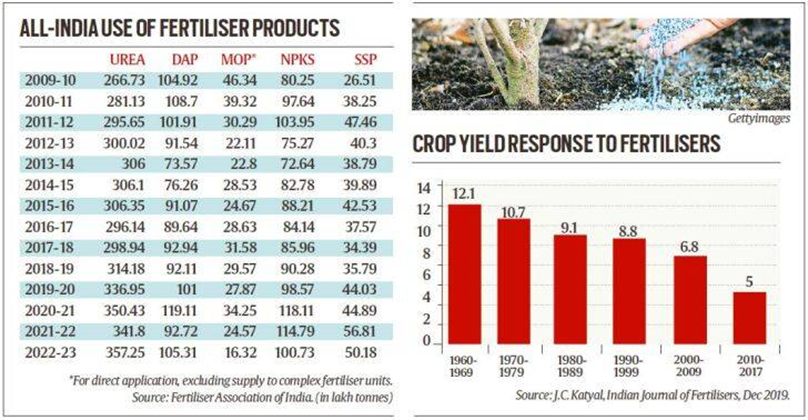Issues Related to Fertiliser Subsidies
26-08-2023
12:26 PM
1 min read

What’s in today’s article?
- Why in News?
- Urea Consumption in India
- Government Efforts to Reduce Urea Consumption in India
- Why did Government Efforts to Reduce Urea Consumption Fail and its Impact?
- What needs to be Done to Reduce Urea Consumption?
Why in News?
- Sales of urea crossed a record 35.7 million tonnes (mt) in the fiscal year ended March 31, 2023.

Urea Consumption in India:
- Like humans, crops need nutrients - primary (N, P, K), secondary (S, calcium, magnesium) and micro (iron, zinc, copper, manganese, boron, molybdenum) - for plant growth and grain yield.
- Fertilisers are essentially food for crops, which provides essential nutrients to the crops.
- High doses of these fertilisers produced more grains and led to the success of the Green Revolution in the 960s.
- However, crop yield response to fertiliser use has more than halved over time. For example, 1 kg of NPK nutrients yielded 12.1 kg of cereal grains in India during the 1960s, 5 kg during the 2010s.The underlying reason has been the disproportionate application of N by farmers.

Image Caption: Fertilizer Consumption in India
Government Efforts to Reduce Urea Consumption in India:
- The introduction of the nutrient-based subsidy (NBS) regime in 2010.
- Under NBS, the government fixed a per-kg subsidy (unlike the earlier product-specific subsidy regime) for each fertiliser nutrient: Nitrogen (N), phosphorus (P), potash (K) and sulphur (S).
- It aims to promote balanced fertilisation by discouraging farmers from applying too much urea (46% N), di-ammonium phosphate (DAP - 46% P plus 18% N) and muriate of potash (MOP - 60% K).
- NBS was expected to induce product innovation, besides more use of complex fertilisers (having lower concentrations of N, P, K and S in different proportions) and single super phosphate (SSP - containing only 16% P but also 11% S).
- In 2015, the Centre made it mandatory to coat all indigenously manufactured and imported urea with neem oil.
- Consumption did dip in the initial two years, but that trend reversed from 2018-19.
- This was followed by replacing 50-kg bags with 45-kg ones in 2018, and the launch of liquid ‘Nano Urea’ by the Indian Farmers’ Fertiliser Cooperative (IFFCO) in 2021.
- None of the above government measures for checking illegal diversion for non-agricultural use, increasing nitrogen use efficiency have failed in reducing urea consumption.
Why did Government Efforts to Reduce Urea Consumption Fail and its Impact?
- The failure of NBS:
- The data reveals worsening of nutrient imbalance, with urea consumption rising at the expense of NPKS complexes and SSP.
- This is because the maximum retail price (MRP) of urea is going up by a mere 16.5% from Rs 4,830 to Rs 5,628 per tonne post the introduction of NBS.
- The current per-tonne MRPs (Rs 5,628 for urea, Rs 27,000 for DAP and Rs 34,000 for MOP) are nowhere compatible with a 4:2:1 NPK use ratio generally considered ideal for Indian soils.
- The price controls on DAP, with companies not allowed to charge more than Rs 27,000 per tonne.
- Decline in nitrogen use efficiency (NUE) and crop yield:
- NUE refers to the proportion of N applied mainly through urea that is actually utilised by crops to produce harvested yields.
- NUE in India has fallen from 48.2% in 1962-63 to 34.7% in 2018, which was below the global average of 45.3% and 53.3% for North America in 2018.
- This has led to the reduction of crop yield response to fertiliser use by more than half over time.
What needs to be Done to Reduce Urea Consumption?
- The obvious solution is to reduce the consumption of N and promote products containing other nutrients in desired (crop- and soil-specific) combinations.
- For this, the government should make incorporation of urease and nitrification inhibitors compulsory in urea.
- These are chemical compounds that inhibit the activity of urease (a soil enzyme that breaks down urea into ammonium and further to ammonia) and nitrifying bacteria (that convert ammonium to nitrate), making more N available to the crops.
- There are two approaches to cut urea consumption - raising prices and improving NUE - enabling farmers to harvest the same or more grain yields with fewer bags.
- Nano Urea - ultra-small size of its particles (20-50 nanometers - is primarily aimed at boosting NUE by allowing easier penetration through the stomatal pores of leaves.
- IFFCO claims that a single 500-ml Nano Urea bottle containing just 4% N can replace at least one 45-kg bag of regular 46% N urea.
- If the government wants to promote Nano Urea (for foliar application directly to the leaves), it may have to subsidise the cost of spraying.
Q1) What do you mean by organic farming?
Organic farming can be defined as a system of management and agricultural production that combines a high level of biodiversity with environmental practices that preserve natural resources and has rigorous standards for animal welfare.
Q2) What is Zero Budget Natural Farming (ZNBF)?
ZBNF guides the farmers towards sustainable farming practices thus helps in retaining soil fertility, to ensure a chemical free agriculture and ensure low cost of production (zero cost) and thereby enhancing the farmers income.
Source: Why urea rules India’s farms
